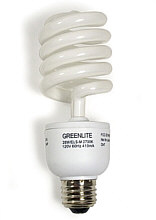









Overview
Our internal General Business Practices audit was implemented to examine
items and criteria that would typically be evaluated in a home energy
evaluation. As a result, we have taking the following measures;
 Light Bulbs
Light Bulbs
Where possible, we have gradually switched our lighting systems to accommodate
fluorescent and compact florescent light bulbs. Compact florescent light
bulbs use up to 75 percent less energy than standard incandescent bulbs
and last up to 10 times longer. If every North American home replaced
just one light bulb with an ENERGY STAR qualified bulb, we would save
enough energy to light more than 3 million homes for a year, more than
$600 million in annual energy costs, and prevent greenhouse gases equivalent
to the emissions of more than 800,000 cars. Standard incandescent bulbs
use only 5 to 8 percent of their energy to produce light. The
rest is dissipated as heat.
Motion Detectors
Motion or occupant sensors detect not only the presence of a person in
a particular area but also detect the absence of a person as well. The
way they work is fairly simple and straightforward. The motion detector
itself is designed to sense both the presence and the absence of a person,
send the appropriate message or signal to what is called the control
unit which then processes the information and sends a signal to a controllable
switch which then either opens or closes a relay which either turns lights
on or turns them off. The occupant sensor is a very effective energy
savings device because of its capability to turn off lights when a room
or area is not being used.
Computer Monitors
ENERGY STAR qualified computer monitors use from 25–60% less electricity
than standard models, depending on how they are used.
 Using Recycled Paper
Using Recycled Paper
We have pledged that all new printed material such as brochures, letterhead,
information packages will be printed on paper with 100% recycled content.
It is common sense that making new paper from old paper is easier on
the Earth. It helps to conserve forests, because it reduces demand
for wood. It conserves resources and generates less pollution during manufacturing
since the fibres have already been processed once. As well, it reduces
solid waste because it diverts unusable paper from the waste stream.
Paper with 100% recycled content reduces the demand on forests for
wood; conserves energy, chemicals and water consumed during paper manufacturing;
and reduces both solid waste and greenhouse gas emissions."
Recycling Program
Everyone knows recycling means less waste going to our landfills. Thanks
to our dedicated staff, we have implemented a recycling program that has
had great success. In the coming years we plan to further reduce the amount
of waste which is sent to our landfill. That being said, the greatest
environmental benefits of recycling are related not to landfills, but
to the conservation of energy and natural resources and the prevention
of pollution when a recycled material, rather than a raw material, is
used to make a new product.
Pesticide Use
We have opted to stop the use of pesticides on our property and this
is why. Pesticides can potentially affect everyone’s health. They
can put people and animals at risk, particularly young children due
to their smaller size and under-developed immune systems. Although
the effects of pesticide use over several years or a lifetime of exposure
are not fully understood, the immediate health effects on people who
are accidentally over-exposed to pesticides may include: headaches,
dizziness, nausea, tiredness, stomach cramps, and skin and eye irritation.
Pesticides also pollute water. Protecting the quality of our drinking
water, along with potential health effects described above, are key reasons
for the Erb & Good Family Funeral Home’s decision to stop the
use of pesticides.
Water Conservation
By planting drought resistant plants we have reduced
our need for seasonal watering. Many native plants can survive on rainwater
alone. Our overall outdoor plan includes reducing the amount of grass thereby
reducing the amount of watering required. In the meantime, while following the City of Waterloo by law for watering and through our automatic
timers we water the lawn early in the morning or evening hours to minimize
evaporation loss. It also achieves greater soil saturation and provides
better absorption of the water.